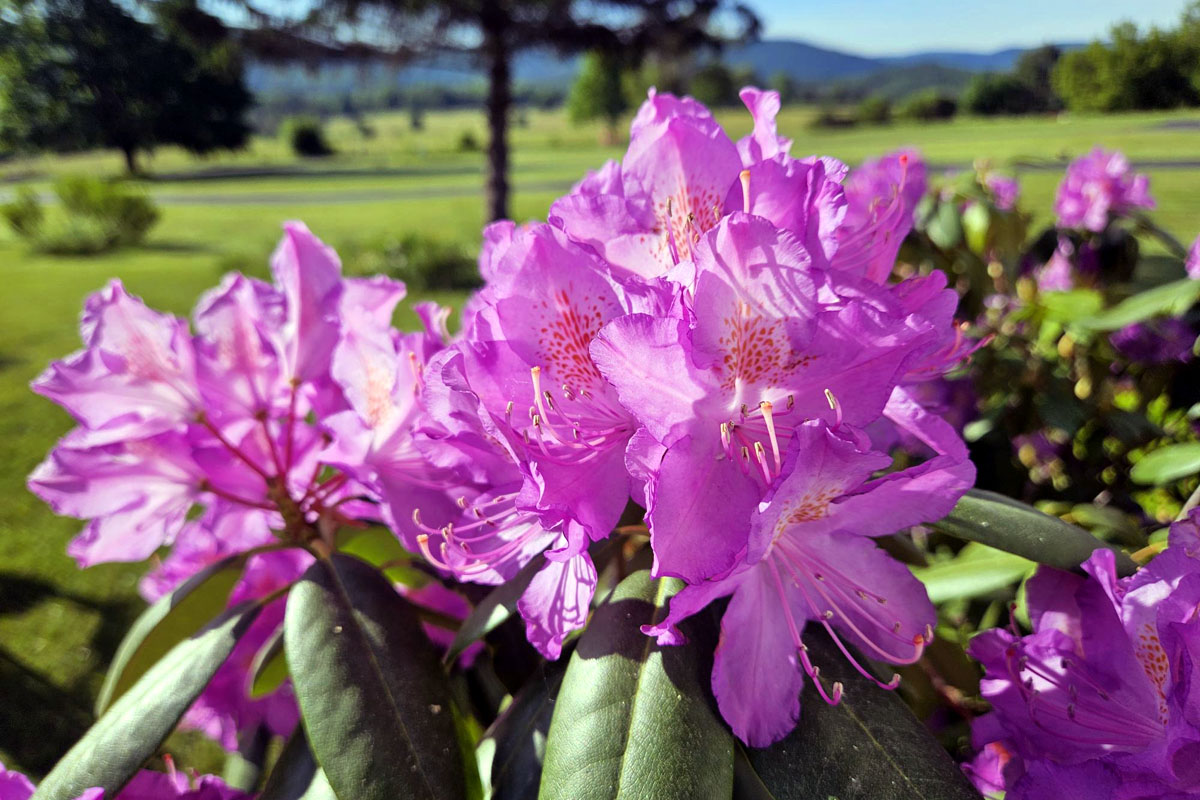Rhodendrons bloom in acidic soil with morning light. My grandmother moved from Ridgewood, N.J. to central Wisconsin and struggled to grow rhododendron. There was no hope. Her Wisconsin soil had a limestone base—too alkaline to keep up with rhododendron needs. Enjoy the right plant in the right place!
The recent dry week has sent me (and my helpers) out to water the vegetables and newly planted perennials. Water in the morning, preferably before 10 a.m. Water will have a better chance of soaking into the ground and not evaporating in the heat of the day. Also, water at the soil level, not overhead. This serves two purposes. First, the water gets directed into the soil where it quickly soaks in with less evaporation. And second, by keeping water off leaves, you reduce the chance of fungus development.
This brings me to another reason for mulch: The soil surface will dry quickly. You want your water to swiftly flow under the mulch to saturate the soil and not splash up on plants. For mulch in a vegetable garden, use straw or salt hay. The inexpensive straw can be incorporated into the soil easily at season’s end. Salt hay comes from salt marshes. The salt hay breaks down more slowly and any salt hay seed will not germinate in your vegetable garden because it needs salt water to germinate!
Last week I planted my tomatoes, and this week I added tomato cages to support them. It is always easier to put supports in place while our plants are small. This helps prevent root damage as you fuss with the support. I have seen many different strategies for supporting tomatoes. You can put in one stake and tie the tomato’s main stem to the stake in intervals. That sounds like too many visits to each plant through the season. I have other things to attend to.
Some people use an arbor-like structure and tie the tomato plant to the structure as it grows. Again, that seems like too much tying and adjusting. Once the tomatoes are in the ground, I want my only responsibility to be watering—and picking of course.
I had a few extra tomato plants left over from last weekend. I decided to plant them in large, seven-gallon containers adjacent to my vegetable beds. The pots are about 12 inches deep, plenty of room for one tomato plant. You could also do this with bush squash or bush cucumber.
Squash seeds are planted in their own section of raised bed, and I have added cosmos and dill weed to attract the parasitic wasps. I flattened and perforated old coffee bags to make reflective plastic sheets to go around the squash seedlings. The seeds should germinate in about a week.
No iridescent Asian beetles yet, but I have asparagus beetle larvae. I am controlling asparagus beetle with products containing pyrethrin. You can also use neem oil. These are organic, broad-spectrum sprays and will harm bees on contact. You can also attract parasitic wasps (to eat the beetle eggs or larvae) with alyssum or dill weed. I don’t have these flowers yet, so I am spraying at day’s end when the bees aren’t around.
Also, my asparagus bed stands apart from the rest of the vegetable garden. Sadly, the ferny leaves get whipped around on our hill. I have installed a removable corral for the stems because I need these to photosynthesize and feed my asparagus roots for next year.
Once the asparagus becomes more robust, I probably won’t bother controlling the beetles with a spray. Spraying can become expensive and less effective over time compared to having diversity in your gardens, meaning I encourage a little bit of everything: plants, insects, soil types, shade, or sun. All promote life and ecological balance. For example, years ago, I planted arrowwood (Viburnum dentatum) right as the invasive alien viburnum leaf beetle moved into the area and devoured every young arrowwood around. It was bad. My two shrubs struggled. Sprays were useless. Nurseries stopped selling this native plant. Now about 20 years later, I have a beautiful arrowwood blooming with just a hint of beetle damage. The theory is that native predators (birds and wasps) have discovered this invasive species and added it to their diet. Hooray!
The week’s garden tasks still included edging. Keep edging and weeding to prevent small weeds from becoming bigger problems. Crab grass and violets exploded last week, and I will keep pulling them out when I see them. Loosening up the soil around your preferred plants makes it easier to pull the weeds as well. With so much to do to get ahead of weeds and garden pests, I encourage you to find help! With a little direction, you can find a relative or companion to water or share the weeding. Make it social! Thank you to my family!
Remember all those amaryllis bulbs from months ago? I have found a protected, shady part of the yard to bring the bulbs—currently in their green, leaf-growing stage. By having them outside in the shade, I give them the benefit of bright light without too much direct light that could burn the leaves. Many tropical houseplants will enjoy a summer holiday outdoors where they can soak up brighter light too. Don’t put these houseplants in the direct sun, however. We have them as houseplants because they will grow in low-light situations. Direct summer sunlight will damage them.
I have purchased and planted with enthusiasm this spring, and, naturally, not everything looks great. My moss phlox—so pretty at installation—nearly dried up to a crisp! The green foliage was shocked by the very hot, sunny, and dry soil of my planting site. I am watering more often now, and the plants should survive to next year, but they don’t look good even though I have provided their ideal growing conditions. Remember: Your new plants are babies, unfamiliar to you and your landscape. Many types of perennials, annuals, shrubs, and trees will show some shock by yellowing or dropping of leaves. Too much moisture as well as too little can cause leaves to turn yellow. Water deeply and then again only when the soil is dry to the touch.
Last week, I potted my dahlias outside to get warm in the sunlight rather than start them indoors and try to acclimate them. My trick is to plant the dahlia in one pot and place that pot in a larger, deeper pot that will house a skirt of colorful annuals. The dahlia containers are still a work in progress. Good thing summer doesn’t start for two more weeks.
I call myself the Lazy Berkshire Gardener because I don’t want to work too hard in my gardens. I want to enjoy them. I find it easier to observe my landscape and let the compost happen, the water pool up, or daisies to self-sow. I look for ways to do the minimum task for the biggest impact. For example, mulching is better than spraying and much better than weeding all season. I look for beautiful, low-maintenance plants that thrive in or at least tolerate my garden conditions. Plus, I’m willing to live with the consequences if I miss something.

